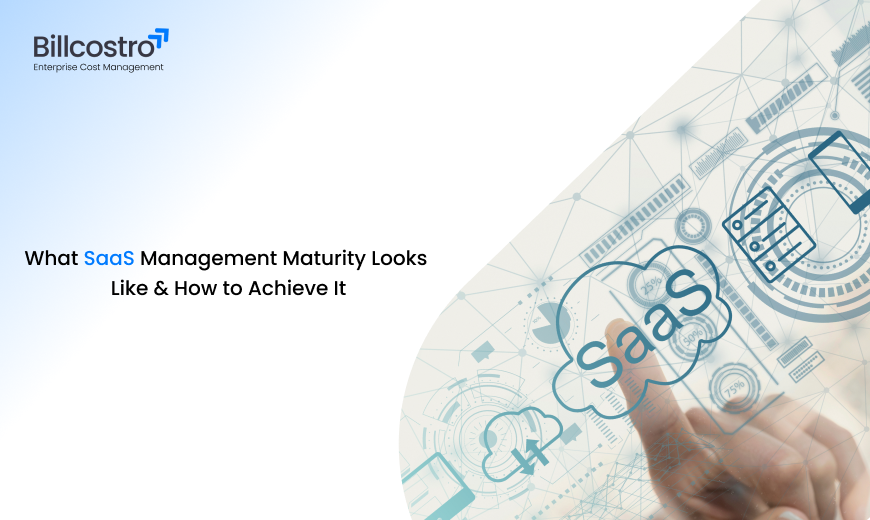
July 9, 2025, 9:03 a.m.

Modern businesses operate in a cloud-first world, and they have seen Software as a Service (SaaS) become the primary infrastructure that supports their operations. To be more specific, teams are utilising multiple SaaS platforms for various functions, such as CRM, communication, finance, and HR, more frequently than ever before. Nevertheless, the benefits of this convenience have a dark side in the form of complexity; thus, effective SaaS product management remains the only correct solution to this issue.
It becomes a strategic necessity as your organisation expands to manage its software stack in an organised and scalable manner, while also making it cost-effective. It is here that the SaaS management maturity model fits perfectly. This framework serves as a good guide that helps organisations understand their current situation in their SaaS lifecycle and the path to achieving the best in software governance, if they decide to move forward.
We will discuss various levels of SaaS management maturity, the issues that exist at each stage, and the necessary tools and methods to control your entire SaaS environment effectively.
The average mid-sized business has more than 100 SaaS applications. Without any kind of management, this situation results in:
Uncontrolled spending
Security risks from shadow IT
Poor user adoption
Data redundancy
Efficient SaaS product management solves these problems by providing a strategic approach to application discovery,
The SaaS maturity model is typically divided into four key stages. Here's how they look:
1. Ad-Hoc (Reactive Use)
Signs You’re Here:
No centralized view of SaaS tools
Teams independently buy software without IT knowledge
Expenses are scattered across departments
Renewals often happen without proper evaluation
At this stage of the relationship, SaaS usage is still reactive and the teams purchase tools only for immediate needs, no central tracking or management area exists. Finance and IT typically have little visibility into the number of tools in use, or their ROI.
Risk: Wasted spend, duplicate tools, and major security concerns.
How to Move Forward:
Conduct a SaaS audit to identify all tools
Begin cataloging spend and usage
Introduce basic controls on new tool adoption
2. Managed (Operational Oversight)
Signs You’re Here:
IT or procurement team begins managing licenses
Tools are categorized by function (marketing, sales, HR)
Renewals are reviewed by finance or admin heads
Cost-saving conversations begin
This is the point where teams have partial control over the software stack. They utilize simple SaaS management tools or spreadsheets to keep track of software usage. Budgets are being examined and shadow IT is being tackled.
Risk: Manual tracking leads to missed renewals, underused tools, or scattered reporting.
How to Move Forward:
Implement a centralized SaaS management system
Define approval workflows for new purchases
Assign software ownership by department
3. Defined (Strategic Governance)
Signs You’re Here:
At this stage, organizations shift from operational oversight to strategic control. The implementation of SaaS is aligned with business objectives. There's an effort to consolidate vendors, optimize licenses, and monitor user engagement.
Benefit: Real-time data drives better SaaS decisions; budget control improves significantly.
Set up alerts for low adoption or inactive users
4. Optimized (Proactive & Predictive)
Signs You’re Here:
SaaS tools are continuously reviewed and optimised
Future purchases are planned based on forecasting and spend analytics
Automated workflows take care of approvals, onboarding, and offboarding
Vendor negotiations are supported by usage and performance data
This is the peak of SaaS management maturity. The organisation is not using only SaaS management tools for control, but also for capabilities and innovation. Each application is justified, measured, and harmonised with the wider business strategy.
Benefit: Highest ROI from SaaS investments, least waste, and a culture of responsible tool adoption.
How to Stay Here:
Employ AI-driven tools for predictive spend and risk detection
Encourage collaboration between finance, IT, and business units
Wherever you are in your SaaS journey, here are key steps to move forward:
Start with Visibility
Map your entire SaaS ecosystem. Identify what tools you’re using, who uses them, and how much they cost.
Assign Ownership
Every SaaS tool should have a business and technical owner who is responsible for its lifecycle.
Standardize Procurement
Use approval workflows to prevent unauthorized purchases. Involve IT and finance early in the decision-making process.
Optimize Regularly
Review usage reports to cancel unused tools, downgrade unused licenses, or switch to better platforms.
Automate Workflows
Use platforms that automate user provisioning, access controls, license tracking, and renewals.
Invest in the Right SaaS Management Tools
Platforms like Billcostro, Torii, or Zylo help streamline everything—from spend visibility and license optimisation to compliance and renewals—making it easier to progress through the maturity model efficiently.
As organisations move along the stages of SaaS maturity, the right tools can have a huge impact. Billcostro is a modern SaaS and expense management platform that aims to provide transparency, control, and automation in your software ecosystem, especially for growth-oriented businesses and startups.
At every step, here is how Billcostro comes to your aid:
Visibility from Day One: Receive a unified picture of all SaaS vendors, tools, and license costs across departments.
Centralized Control: Automate approvals, renewals, and vendor onboarding with customizable workflows.
Usage-Based Optimization: Monitor active vs. inactive licenses and get rid of those that are underutilized.
Proactive Alerts: Receive alerts on the status of renewals, overages, and tools that are not performing well in a timely manner.
Integrated Financial Reporting: Link all your financial systems and SaaS data for budgeting, forecasting, and audits without any hitches.
Billcostro transforms the SaaS model into a strategy, enabling your company to scale confidently without compromising spend, security, or software value.
Ready to take charge of your SaaS ecosystem? Book a demo with Billcostro and bring efficiency to every layer of your expense management.- Click here